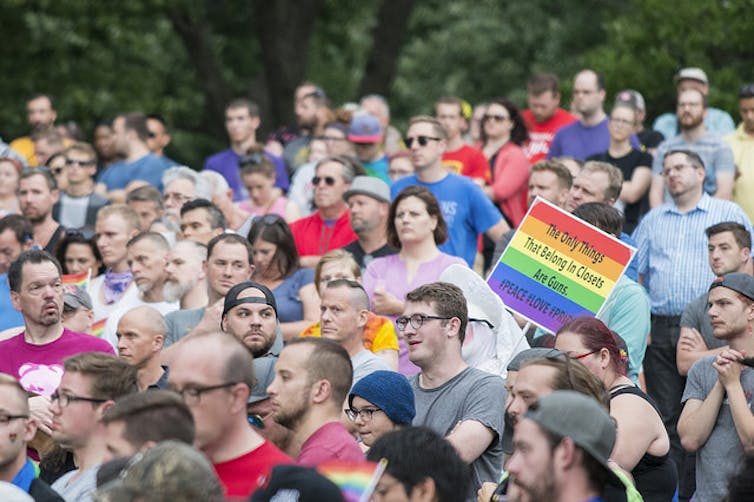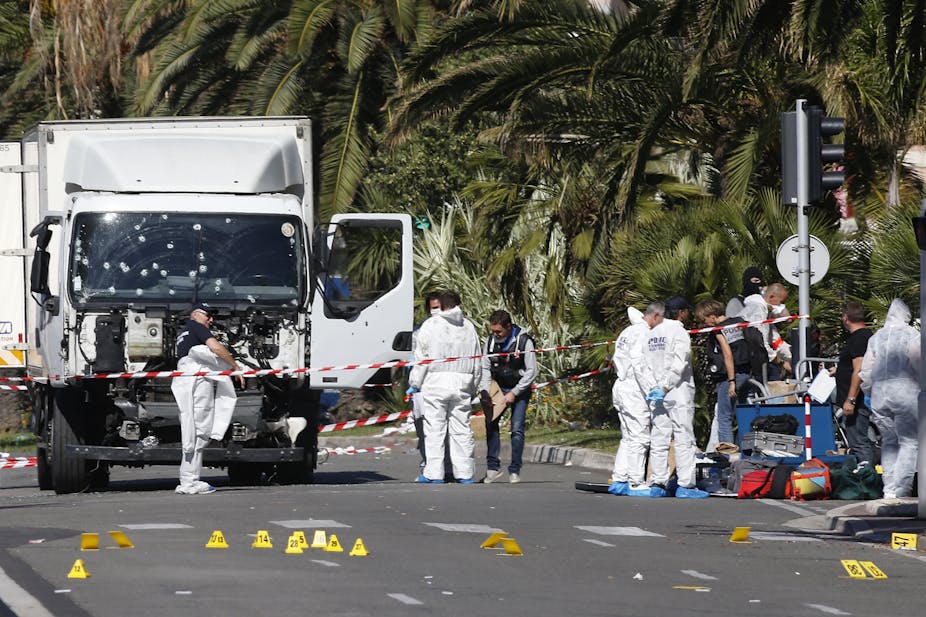With every terrorist attack it has become increasingly difficult to determine a “standard” profile of the perpetrators to understand where and how radicalisation takes place.
The young men who carried out the 2004 Madrid and 2005 London attacks met in Internet cafés and neighbourhood mosques, in libraries and sport clubs. They watched videotapes of the wars in Chechnya or Bosnia, and the Israeli-Palestinian conflict.
Many came from the postcolonial immigration. They were first-generation, like those of Madrid, or second-generation, like London. The 9/11 attackers – most of them from Saudi Arabia – followed international networks to training camps in Afghanistan, Pakistan and Yemen.
Individualisation of terrorism
Since London, attacks have been called “homegrown”. That’s in reference to individuals becoming radicalised and striking the countries in which they live, and of which they can be citizens or even native-born. While sometimes referred to as “lone wolves”, they often work in groups formed spontaneously in neighbourhoods, mosques and associations. They also can be part of networks that allow them to travel to the land of jihad and prepare their actions in home countries. They are, in most cases, young people from immigrant backgrounds.
Lone wolves or homegrown, many see themselves as local soldiers of the global jihad. Recent examples include the San Bernardino couple in November 2015 and the Orlando shooter in June 2016 in the US. The case of Mohamed Lahouaiej Bouhlel, who killed 84 people on July 14 in Nice, France, is less clear-cut. But the pattern of a group of friends (as in Madrid and London), siblings (the Kouachi, Abdeslem, and Tsarnaev brothers), or members of a tribe (in the case of 9/11) has given way to individuals isolated in front of their screens at home.

Suicide bombers use their body as a weapon of war and as a testament to their perceived self-sacrifice. It’s a way to ensure their belonging to a “community”, real or imagined.
From the mobility of the physical body – highlighting the image of the martyr – comes the move to the truck as a weapon, as in Nice. The truck is mobile too, but incomparably larger and more deadly, and its “success” magnified by speed. The variety of weapons used highlights the dark imagination of suicidal acts fed by social networks and websites fuelled by radical Islam.
The call to diaspora
While the roots of al-Qaeda stretch back to the late 1980s, it is on today’s online networks that young people become familiar with the tenants of radical Islam. That is where they hear the speeches that attract them to a single narrative of belonging to the Ummah – the global Muslim community where nation, religion and land are blurred. The online discourse on Ummah refers to a new “imagined geography” as a representation of deterritorialised and denationalised world.
The non-territorial borders of Ummah follow the networks – formal or informal – that transcend the boundaries of states and nations. They thus create a kind of territory – invisible and unfenced – and political community that seeks to consolidate itself through speeches, symbols, images and objects that circulate through websites that have become the main space of power and influence. Leaders speak to Muslim youth of the diaspora as part of Ummah, citing the traditional hadith (or narrative): “The Ummah is like our body. If one part hurts, the whole body aches.”
The concept of jihad as it’s understood today hinges on perceived membership in the Ummah, a global nation conceived as a foundation for a new identity. This allows those who have chosen the path of jihad to step outside traditional nation states and identify with a borderless community, as with a non-territorial nation.
Extraterritorial wars
This new dynamic transforms territorial wars into extraterritorial wars. But in a Westphalian world, territory remains the space where power is concentrated. When a faction of al-Qaeda took control of an area the size of the UK on the border between Syria and Iraq, proclaimed itself to be the “Islamic State” (IS) and named a caliph, it had no legitimacy in the eyes of international law and the nations concerned. Yet it confirmed the essential role of territory within the tactics of war and an expansionist strategy. The areas seized serve to attract not only the young Muslim diaspora, but also others from Europe, the Caucasus and Asia, coming together with local tribes to form an “army”.
In February 2016 testimony before the US Senate Armed Services Committee, James Clapper, Director of National Intelligence, stated that since 2012 more than 38,200 foreign fighters – including at least 6,900 from Western countries – have travelled to Syria from more than 100 countries. In Europe, France and Belgium are the largest sources of recruitment. In the Middle East, it is Jordan, Egypt and Tunisia. From Asia, Pakistan, India and Bangladesh provide most of the recruits.
These young people, regardless of their national origin, see themselves as mobilising for the caliphate. They’ve made it their “homeland”, the homeland of an imagined diaspora of Ummah. No matter if they are organised in groups, or networks, local or global, no matter if they act individually or in a collective organised way their identification – individual and/or collective – with the Ummah seems to find a ground in this “diasporic” aspect of a dispersion.

Hence the paradox. Out of diasporas often rise the vision of a re-territorialisation, “restoration” or “recovery” of a real or mythical territory, yet still sovereign. The discourse that underlies the idea of transforming the Ummah into a global nation relies on its members finding unity based on overlapping identities (national, regional, religious, linguistic). It also relies on shared experiences (colonisation, exile or emigration). Furthermore, it relies on constant references to a denationalised and de-territorialised “we” that establishes itself within the conceptions of the diaspora and the nation.
If diasporas encourage a sort of “nationalism” that is abstract yet anchored in a physical territory, the Ummah generates new impulses based on the transnational communities and networks that seek to consolidate themselves through the strength of a single story fed by symbols, images and objects.
In the first half of 2016, coalition strikes have inflicted significant losses on the “Islamic state”. Yet the soldiers of the caliphate continue their work in a “de-territorialised” way. They attack where they are, and thus recall the objectives of both territorial “state building” as well as a global expansion through the “imagined diaspora” that motivates foreign fighters.
Every attack – even the most isolated and individual – is claimed by IS. It uses these claims to further its global ambitions and appropriate a war wherever the self-identified solders and/or combatants act.
This back and forth between the local – territorial – and the globalised forms of radical Islam, the shifting profiles and widespread locations of its fighters, and the limitless imagination of weapons of war are a new challenge to nations in their fight against radicalisation.


